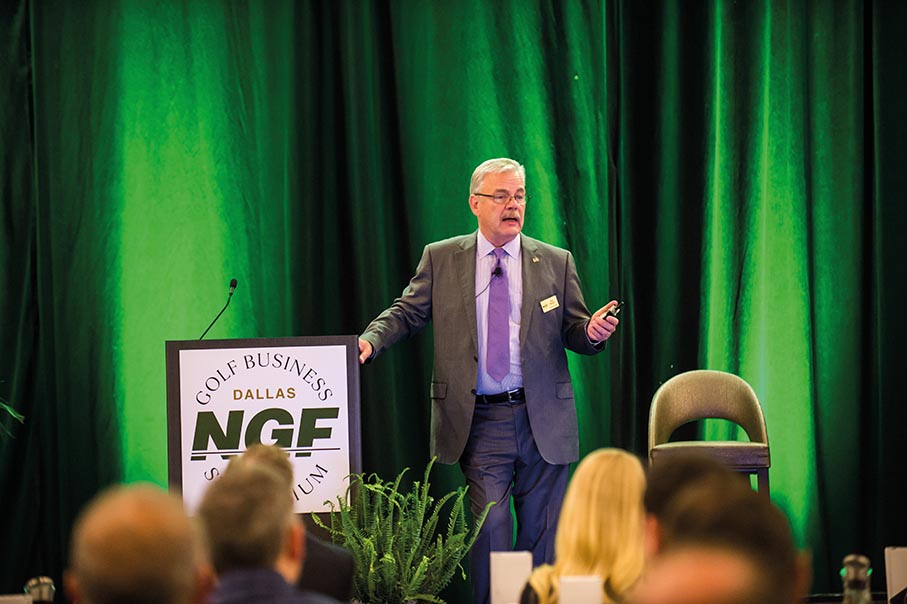“Golf’s Achilles heel is retaining clients”
In a country that is the world’s leading golfing power – for the number of golfers and fans – Joe Beditz arguably knows more about the ins and outs of the golf industry than anyone else. A mid-handicap golfer, he is the president and CEO of the National Golf Foundation (NGF). In 1984 he became research director of the foundation, whose staff includes the world's largest full-time research team dedicated to the business of golf. "At the time," he recalls, "I thought it would be fun to do it for a couple of years and, well, after all these years it's still fun and I'm still here enjoying our work with the leading golf companies."
In the NGF’s view, what are the main challenges facing the sport and the golf industry in general, in the short and medium term?
The most pressing challenge continues to be retention. And that’s particularly relevant now – will the industry be able to retain the golfers who turned and returned to the game during the pandemic? Retaining customers has been golf’s Achilles heel for some time. Consider that in the past five years the U.S. welcomed over 13 million beginning green-grass golfers. And yet, even with the COVID bump we experienced in 2020, the participant base has seen a net gain of about 700,000 over that time. That’s a problem that speaks to an issue with either the experience we’re providing or the perceived value among newcomers.

Which businesses are booming and which ones are in decline or in jeopardy in the golf sector?
Recently, it’s been a case of a rising tide lifts all ships. The surges in play U.S. courses experienced last year had a profound impact on their financial well-being. But our research indicates that facility health has been heading in that direction, too. As participation has stabilised and lower-performing courses have closed, we’ve seen a better balance in supply and demand. Even with the trend in recent years of more course closures than new openings, the U.S. remains the best-supplied market in the world by a long shot, with five times as many courses than any other country in the world. Equipment manufacturers have been doing robust business as well. You can look to the recent strong Q1 earnings periods for big names like Callaway and Acushnet, the parent company of Titleist. The sale of TaylorMade, for about four times what it sold for in 2017, speaks to the growth opportunity that’s seen in golf – and not just here in the U.S.
Taking into account the fact that, according to the NGF, more than 12 million Americans played golf last year at facilities other than a golf course, how do you attract those golfers from driving ranges and indoor simulators to courses?
And that 12 million number you mention represents those who have never played on a golf course before. There’s another 12 million who played off-course forms of golf, but also play the traditional game. To your point though... even with golf’s boom last year, the participant pool for off-course showed double the growth of “green grass”. This speaks to the growth in that side of the industry and, as we’ve researched it over the years, we’ve seen a correlating increase in not only beginning on-course golfers, but in interest among non-golfers. Whether it’s golf-entertainment, a simulator or a driving range, these options make golf more accessible. They can also be less intimidating for a non-golfer than going to a golf course. Where that’s a positive is that our research shows getting a golf club in someone’s hands, whether it’s in a school golf program or a Topgolf, greatly increases the likelihood that they’ll want to play on a golf course. So, what to do? For course operators in proximity to places like Topgolf and other golf entertainment venues, there’s definitely opportunity to invest in marketing and player development efforts targeted at an increasing number of customer prospects right in their backyard.

Also, how do you convert people who have never played golf but who have been interested in the sport as TV viewers or readers into new golfers? In this situation there would be about 70 million Americans, according to the NGF.
We continue to see a steady increase in what we call latent demand – the interest among non-golfers in actually playing. This measure is up 40 per cent just since 2015. Ultimately, converting that interest into actual engagement comes down to the consumer experience. Golf remains a traditional game in many respects, but we do see continued evolution and ways in which it’s gaining broader appeal for a wider audience, whether that’s music on the course, relaxed dress codes, social media interaction, shorter play opportunities with 3-, 6- or 9-hole loops for the time-conscious, or the growing number of golf communities, associations and leagues that let people feel they’re part of a bigger group.
Women's participation in golf is increasing but it is still quite distant from that of men. What can be done to bridge the gap, to increase the number of female golfers?
Women make up almost a quarter of traditional golfers in the U.S. and that percentage gets quite a bit higher at the younger ages. Just over a third of all junior golfers are girls, for example. The industry did see a rise of nearly a half million female golfers in 2020, pushing the total past six million for the first time since 2007. You can point to a number of reasons why, like more families on the course during the pandemic and people seeking a healthy, outdoor social outlet. But continuing to grow this number means strengthening efforts to make golf welcoming, as the biggest obstacle tends to be that newcomers on the women’s side are more likely to say they’re uncomfortable or intimidated. We’ve seen some significant success in dedicated instructional programs geared toward women that focus more on structure, simplicity and keeping participants informed and prepared.

What is your opinion about technological advances applied to golf clubs and balls, in reference to the increasingly longer distances being achieved? Should we put some kind of brake on product development?
We’ll let our friends at the USGA, the R&A and the sport’s other governing bodies focus on that, but we’ll continue to monitor consumer sentiment – what golfers think and feel. The beauty of golf being one of the nation’s biggest participation sports is that so many of us, as participants, are on an everlasting quest for improvement. There’s always hope that the next great technological advance in equipment will help us hit farther, hit straighter or shoot better scores. Among the tens of millions of everyday players in the U.S., the average driving distance doesn’t show the jumps you might see through the years at the very highest levels of the game. And with that, you’re talking about such a statistically tiny portion of the overall participant base. We keep preaching the need for golf to improve the customer experience and a major part of that is ensuring golfers are seeing improvement, and also having fun.
What influence does big data have when applied to the world of golf? What benefits does it bring to you specifically?
Focusing on NGF’s research capabilities, our efforts keep thousands of members – golf courses and companies – informed of the latest data and trends in the industry. We have the largest full-time research team dedicated to the business of golf. They conduct primary research, analyse secondary data and communicate those conclusions in an independent and objective fashion. Take our definitive databases, for example: golf courses, retailers, companies, industry professionals, and so on. That’s unrivalled in the golf business. Changes to these databases and their content will reveal trends and help us identify areas worthy of further investigation. Knowledge of the golf consumer and individual markets can be invaluable to those in the business, while our market intelligence facilitates decision-making, mitigates risk, and directs sales and marketing strategies.








